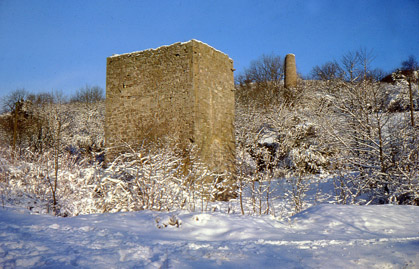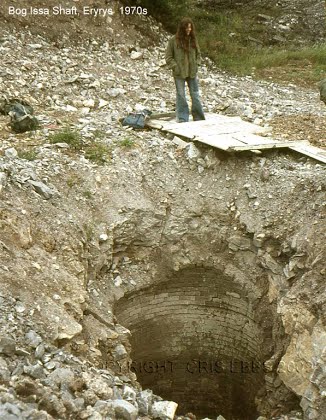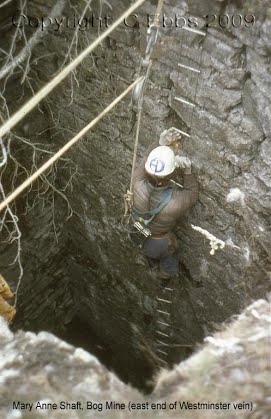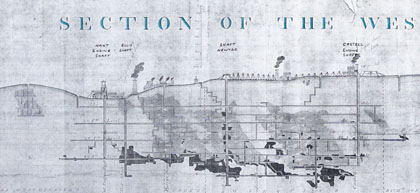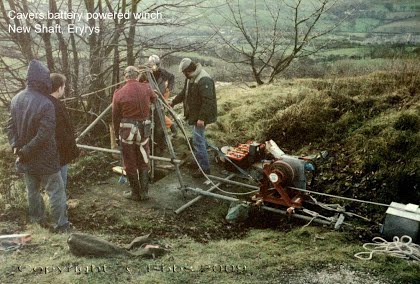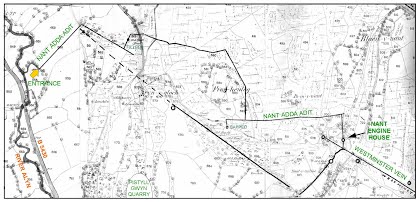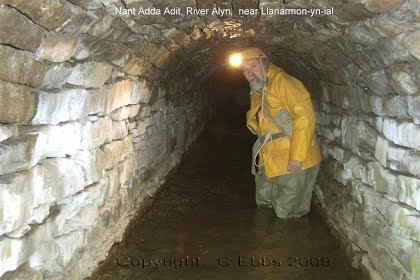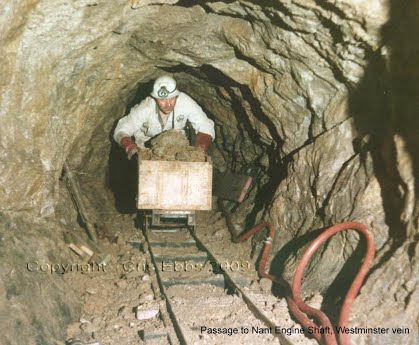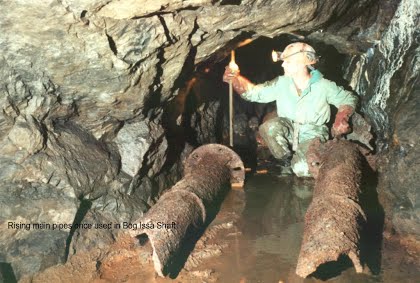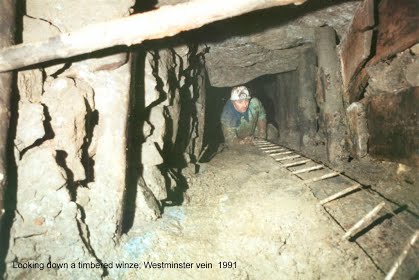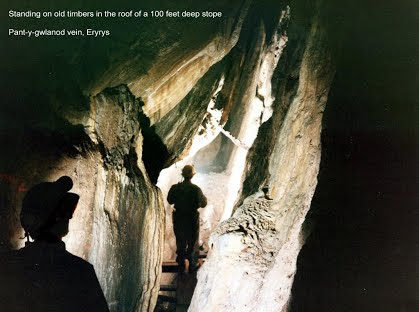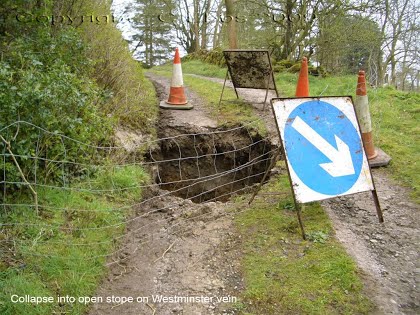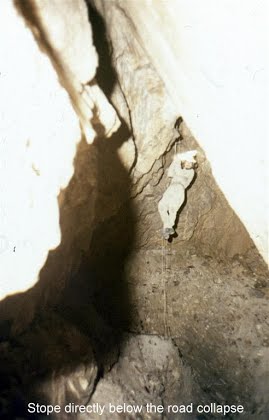Navigation......................................
01.
Home
02.
General Lead Mining History
03a. Halkyn Mines: History
03b. Halkyn Mines: A few artefact photos
03c.
Halkyn Mines: info downloads
03d.
Halkyn Mines: Don Richardson - electrician
03e. Milwr Tunnel: Recent work
04.
MAP: Veins of Halkyn Mountain
05. Blaen-y-nant vein, Eryrys
06. Westminster vein, Eryrys
07. Fron Fownog Flats, Gwernaffield
08.
Pilkington's vein, Loggerheads
09.
North Henblas Mine, Milwr
10.
Deterioration of the mining record
11. Talargoch Mine
A.
Mines lighting old & new
B. Links
C. Further reading
D. Cris's Shop Window
06. Westminster vein, Eryrys
Sub-headings for this page:
Profits for some
Surface remains
Modern exploration
Underground artifacts
An interview with the mine captain, 1863
Click to enlarge:
Cross-section of Westminster vein west from 'The Nant' to the east
at Bog Mine.
Copied from EARP, J.R.
1958. (see Further Reading)
Eryrys - Llanarmon: mining in general
Although lead was mined in Roman times in areas such as Halkyn Mountain and Minera, the earliest documentary evidence tells that small-scale mining was being carried out at Eryrys during the 13th century, although no mention is made of which veins were being worked. During the next 400 years it seems that mining was sporadic, often only being carried out in summer months when the workings tended to be dryer. Mining at this time was frequently carried out by local farmers wishing to supplement their meagre incomes. Development of the mines was hampered by a combination of limited financial investment and the medieval technology.
A major boost for lead mining came with the transfer of mineral ownership from the Crown to private hands. Grosvenor estate were one of the first to acquire mineral rights over much of Halkyn Mountain, Minera and the Llanarmon - Eryrys area in 1635. Until that time miners had operated under a set of ancient 'mining laws' governing every aspect of lead mining. The laws were very similar to those, still upheld in Derbyshire, where they are today administered by a Barmoot Court. Grosvenor estate felt that the laws hindered mine development and took legal steps to quash them. Thereafter the Grosvenors leased out their mineral rights, often for periods of 21 years, but the family also worked their own mines. Initially the Grosvenors mines were at Halkyn and Minera, but from about 1735, they began working mines at Llanarmon – Eryrys, amongst them being Belgrave Mine half a mile north of Eryrys and Nant-y-Palmau (today known as The Nant) on Westminster Vein, half a mile south of Eryrys.
As mines became deeper, flooding increased, and many mines closed as a result. Some ingenious pumping contraptions were utilised, most of which struggled to match up to the task. Mining technology didn’t improve significantly until the introduction of gunpowder for blasting around 1700 which resulted in improved rates of tunnelling of up to one foot per day (still rather modest when compared to a rate of up to 20 foot per day in more recent times). A few years later steam-powered pumping engines were introduced. These were inefficient and dangerous to operate at first, but were much improved over the years and developed into the well-known Cornish pumping Engine. These were used at most Eryrys and Llanarmon-yn-ial mines and enabled previously flooded veins to be worked to increasing depths below surface. Westminster vein in the 1850s had a total of six Cornish engines in operation at the following shafts: Nant Engine; 'White Sands'; Castell, Bog Issa, Mary Anne and Bog East.
Profits for Some
With the introduction of modern technologies and good ore prices, lead mining production increased year on year eventually reaching its zenith in the early 1860s. In that year Flintshire & Denbighshire together produced over 45% of Britain's ore. A geologist at Halkyn Mines calculated that in the two centuries prior to 1939, the lead and zinc mines of Flintshire and Denbighshire produced mineral wealth to the value of twenty million pounds. George Hughes, agent for Grosvenor Estate reported the raising of ore to the following values in local mines:
Despite these figures the poor miner was paid a meagre wage. At many mines wages were paid in mine tokens which could only be spent at the mine shop where men bought their own tools and candles. Known as the 'tribute system', wages were proportional to the amount of ore raised; a ‘grim prospect’ for miners working a vein that was 'pinching out'. Such practices and poor conditions underground only began to improve during the 1800s following Government legislation.
By 1868 the Eryrys - Llanarmon mines were again idle, worked out as deep as drainage and pumping would allow. Although no deep adits were geographically possible at Eryrys, one tunnel known as the Nant Adda Adit, was extended and in 1897 it struck the Westminster Vein beneath Nant Engine Shaft. As a result the mine produced ore for a few more years before closing for the final time in 1903.
It had been planned to extend the 10 miles long Milwr Tunnel, to drain the mines of Eryrys and Llanarmon-yn-ial, but this tunnel today (which begins at Bagillt on the Dee Estuary), terminates at the hamlet of Cadole near Loggerheads. Another plan to tunnel into the area from near Treuddyn failed to leave the drawing board.
Click on image to enlarge
Cross-section of
Westminster Mine between Nant Engine Shaft and Castell Shaft. Note the
three Cornish engine-houses and three stepped footway shafts, used for
miners access.
The buildings near
the chimney were once a school for miners children. Note also the horse
whim shown at Castell Shaft and the miners coe sited above the central
footway shaft.
The lower half of the
workings shown are now flooded at the 30 fathom level (180 feet), the
level at which the Nant Adda Adit now drains the mine.
Westminster vein
The Westminster vein was the most productive vein in the area. It has a major off-shoot known as Pant-y-gwlanod vein which runs parallel to Westminster vein and lies about 50 yards to the south. They form a single vein in the area to the west of Nant Engine shaft. A deep tunnel drains both Westminster and Pant-y-Gwlanod veins. Known as Nant Adda Adit, it was begun from the River Alyn half a mile to the west of the veins some time after 1850; but work on the tunnel ceased for a while after after it had been driven a distance of about 500 yards from the portal. Driving was only resumed in 1896 in the course of exploratory work supervised by the well-respected mining engineer Matthew Francis. Francis however rarely witnessed progress and was instead supplied with weekly hand-written progress reports by his underground manager, mine captain John Roberts. When the tunnel struck Nant Engine Shaft in 1897, most of Westminster and Pant-y-gwlanod veins drained down to river level. As Nant Engine Shaft was connected to Castell Shaft (over 600 yards to the east) by deeper flooded workings, the tunnelling team moved their equipment to Castell Shaft. From here they drove a further 400 yards east to drain the eastern end of Westminster vein around Bog Issa Shaft. A little more exploratory mining was carried out, including the driving of a 270 yard cross-cut southward from Bog Issa Shaft to intersect the Pant y Gwlanod vein. The vein was found to be unproductive at the point of intersection and money ran out by 1903. The last production figures show that between 1894 and 1900, about 915 tons of zinc ore and 37 tons of lead ore were produced.
Click image to
enlarge.
Plan showing the
erratic route of Nant Adda Adit, presumably in search of the westerly
continuation of the vein at the depth of river level.
NB The
entrance to the Nant Adda Adit lies on private land and permission to
visit must be sought. The tunnel however, is completely blocked by
a roof collapse a short way in and should not be entered.
The mine was also drained in earlier years by at least two shallow adits. One is shown on the plan above and runs south-west from Nant Engine Shaft, but the entrance to this (at SJ196575) is now lost, although part of this adit has been explored in recent years from within the mine. The second shallow adit runs south-west from near Bog Issa Shaft on Bog Mine passing beneath a shaft shown on plans as Shaft Defaid (Sheep Shaft). The entrance to this adit is now filled in (at SJ201572) but when functioning, several steps led down from the field giving access to the passage, water being taken away by a cut-and-cover drain beneath the field. Most of this adit can be explored from within Bog Mine as far as a blockage around 50 metres from the portal.
Westminster vein was worked from Nant Engine shaft in the west through what is known locally as 'White Sands' and 'the Bog' as far east as a shaft near Graianrhyd (Bog East), where limited work was carried out, but these most easterly workings were not physically connected to the main workings and therefore now lie flooded. A chimney still exists at this location. The most extensive workings lie between Nant Engine Shaft and Mary Anne Shaft. West of Nant Engine Shaft, across the hillside, a series of generally shallow shafts were sunk along the line of the vein, but here it was known as Bryn Haidd vein. Three of these shafts however are known to be over 100 feet in depth, although no extensive workings have been found below. Most of the shafts on the westerly end of the vein were capped by NKC Geotech in 1978.
Surface Remains
Nant Engine House (SJ197577) without its roof, is the only fairly complete building on the Westminster Vein. Its chimney also remains some yards up the hillside to the east supplied by a flue. Sadly this chimney is being damaged by tree roots growing into the stonework at its base. It is in danger of collapse without urgent remedial work. The remains of a circular stone powder magazine or possibly a miners ‘coe’ (SJ199575) exist, just south of the track not far from New Shaft. All that remains of the engine house that served both New and Castell Shafts is the base of its chimney (SJ203575). Further east the chimney of Bog East engine house (SJ213567) is almost complete whilst Mary Anne Shaft engine house (SJ209570) now only displays its ruins. A stone from the walls might still be seen bearing the date 1853. Two boundary stones in the Mary Anne Shaft area are inscribed "W.M.Co." (Westminster Mining Co). Finally, the remains of a building or two can still be seen near the portal of the Nant Adda Adit (SJ187578). The vein is clearly marked along the surface by the hillocks formed by the tailings, at one time calculated to amount to over 40, 000 tons, and by many shaft craters.
Modern exploration
Enthusiasts have been examining the underground workings of this area since the 1960s. With the co-operation of local land-owners, their long-term projects have successfully re-opened a significant proportion of the extensive workings between the Nant and Bog areas. They have excavated filled shafts, installed fixed ladder routes and carried out safety work to provide future explorers with safe routes. Westminster vein was first examined by explorers in the 1970s when workings from New Shaft were explored. In 1990 work began to re-enter Bog Mine at the eastern end of Westminster vein. In 1992 a through-trip (New Shaft to Bog Issa Footway Shaft) was established of about a mile in length and which passes through workings over 300 feet below surface. For details about access to these workings, contact Grosvenor Caving Club (see ‘Links’ at top left of this page). The following notes by the club at the time give an idea of the type of work involved: Permission sought from land-owner and entrance cap re-opened with oxy-acetylene - blockage 20ft down excavated to short passage - at a depth of 40ft a major blockage lay perched over a 60ft stope - A scaffolding cage was installed down through the blockage for 20ft. and a platform suspended from its base above the void - Fixed ladders installed below - The next obstacle lay 100ft below the upper adit level where an unstable shaft (see timbered winze photo below) led to a timbered crawl beneath a back-filled stope - About 10 cu. yds. of boulders were removed here to offer an alternative safe route into the roof of an 80ft. stope - scaffolding walkway installed at this point for crossing stope with steel guidewire as handrail - Extensive clearing work followed and permanent ladders were installed throughout. Upper adit level on Westminster Mine reopened by excavating a blocked 25ft. shaft from surface - timber collar fitted to base of ginging - shaft capped and steel access lid and rigid ladder installed - 50yds. along adit, a blockage of spar from the vein was excavated for 30ft giving access to vein and crosscut to Nant Engine Shaft. To allow digging east along blocked vein, rails were laid to the shaft and a tub installed. Nant Engine shaft (capped) was reached via old workings and descended 120ft. to the Nant Adda Adit - this was explored west for 300yds. to a blockage of old lorry tyres - blockage was cleared giving access to a further 700yds. (some 500yd. from portal). Bog Mine connected to Westminster Mine via obscure rise from Nant Adda Adit, west of Castell Shaft - two small blockages excavated and permanent ladders installed throughout - hand-lines fixed over several stopes in floor of 10 fathom level. Platform installed in New Shaft at adit level - 1992, the first through-trip, New Shaft to Bog Issa Footway Shaft. Other projects have been carried out by this club at Pant-y-Gwlanod vein, Belgrave vein and Blaen-y-Nant veins. A more recent project hoped to re-enter the deepest drainage tunnel of Belgrave vein. This drains into the River Alyn near Llanferres but had collapsed at the entrance. Digging through the collapse began in earnest in 1999 and eventually broke through after 7 years work in 2006!
Underground
Artefacts
Major equipment was removed from the mine prior to closure, but small artifacts do remain and include:
An interview with the mine captain, 1863
A Royal Commission looked into conditions in metal mines in 1863. Their committee interviewed the mine captain of Westminster Mine, John Floyd (or John Lloyd as stated in the official Mineral Statistics). During the year of the interview, Westminster Mine produced only 108 tons of lead ore; the mine being almost worked out. The last recorded output was in 1871 when just 5 tons were recorded.
The following extracts are taken from the interview:
How many men have you working underground? We have 48 now; we have 50 sometimes.
What is your lowest level? Taking the lowest level, reckoning the Engine Shaft and altogether, it is 120 fathoms from the surface (720 feet).
How long have you charge of the mine? I have been 20 years in the mine.
How do the men ascend and descend? By ladders.
How do you draw? By the wem engine.
With a skip? No. With kibbles.
How many shafts have you? We have two principal shafts, but we have small ladder road (or footway) shafts as well.
What is the principal level which you are now working at? It is 64 fathoms (384 feet) from the surface.
Have the men any place to change when they come to the surface? Yes; they have a cabin prepared for them with steam pipes in it to warm it.
Have they any warm water? Yes; there is warm water condensing from the engine.
Do the miners reside near the mine? Yes, within two or three miles.
What allowance of candles have they per week? 2 lbs for each man.
What is the price charged? 8d a lb. we charge the miners.
And the same for powder? Yes.
Is there any reduction for club? No; we have no club now; we had a club until the last twelve months.
Is there any subscription for doctor? Yes.
Is the doctor appointed by the adventurers? By the adventurers and the miners. The miners pay 6d per month each man.
Who has the choice of the doctor? He is chosen by the men.
How is it managed? It goes by vote. We let them vote their own doctor.
Did you make any changes for any reason? We made a change. One doctor that we had before lived in Mold, and the doctor that we have now lives at Ruthin. The men were dissatisfied that the doctor living in Mold did not attend regularly annd they wished to change, and we let them choose their own doctor.
Do you keep a month in hand of the pay? Yes.
Do you pay in notes or in small change? In gold and silver.
Do you know of any men suffering from working in mines? There are a few old miners who have been working underground all their days who suffer a little, more or less.
You yourself have suffered? Yes.
Where were you working when you were affected? I worked some years before I had the management of mines in Flintshire, and I think I am suffering from that.
You think that it was brought on by working? Yes, in the lead ore.
What do you think it was occasioned by? I do not know, excepting it was from the dust from the lead ore.
Do you think it was from working in bad air? Yes, I have been working in bad air, and whether it has had some effect or not I do not know.
At what age do the miners generally leave off work? We have had some miners of 60 or 70 years of age working now. They generally leave off working at from 60 to 70.
You have had some experience in Cornish mines? Yes, I worked a little there when I was young.
Comparing these mines with the cornish mines should you say that they were more or less healthy? I think that these mines are worked on just the same system as the Cornish mines.
But with regard to ventilation, how is it? I think that the ventilation is quite as good here as there.
With regard to the health of the men workingin the mines do you think that they complain more or less here than in Cornwall? I think that they complain less here than they do in Cornwall.
When did you leave off working in Cornwall? I was 18 years of age when I left Cornwall. That is about 35 years ago.
The mines are not so deep here? No, not by a great deal.; some of the mines in Cornwall are very deep.
The men invariably ascend by the footways here? Yes, except in the coal mines; in the coal mines the men go up and down in buckets and skips.
Do you not think that the climbing is injurious to them? No, because they are working in different levels; if the men all worked in the bottom of a deep shaft I think that skips would be advantageous.
Do you go much underground yourself now? Yes.
To what depth do you go? The bottom is about 120 fathoms from the surface.
In your opinion, would it be a good thing to have some other method of ascending? It would be an advantage to come up by skip instead of climbing.
How many men have you? 50 altogether, that is driving and sinking and picking ore.
How many men have you picking ore? In the dead bargains they are picking alittle ore; we are getting a little ore in most of the places that we are working in.
Are you picking ore on the surface? A little in waste washes and the hillocks (i.e. White Sands and Bog).
Is it in old workings that your men are principally employed? No, we are extending our levels and sinking in new ground; there are 50 men altogether employed in picking in the old workings and engaged in the new ground.
How do the men pick, is it by day work? So much a ton.
Have they any shelter? Yes, in wet weather; they do not require it otherwise, because they are working perhaps two or three hours in one place and three or four hours in another, where they can get a bit of ore.
Do they pick over all the old workings? All the old hillocks.
How many men and boys have you upon the surface picking the old workings? Two men and five or six boys.
When the air was bad (underground) how far off was it from any shaft; I mean before you holed? Before we holed it was 50 fathoms from a shaft, then we sank and rose to meet (adjoining workings) and then we had plenty of air, but before that the air was flat.
Before you holed was the air bad both in sinking and in rising? Before holed the air was rather dead.
In the deadest time, how many men could you put there? It only requires two men in the 8 hours each piece, 6 men in 24 hours.
Were the candles ever dull there? The candles always burn dull when the air is flat.
Did you use any fan at all? yes
Did that give you a good supply of air? Yes, there was plenty of air.
Can you go up the ladders now? Yes, but I must go up quietly. I cannot go up the ladders as I did 30 years ago. I think that I climbed too fast when I was young.
You were continually catching cold; and you attribute your illness to working underground, and getting hot and coming up to the surface in a perspiration, and not taking care of yourself when you arrived at the surface? I dare say that it is a good deal from that.
How long does the powder smoke generally hang about in your levels? It is according to the air.
What is the common time? In our mine I do not think that it lasts more than an hour in the worst time.
How long does it hang so as to prevent the men from working? It does not hang more than 10 minutes to prevent their working.
Are a good many of your men affected in their chests? A good many have been so affected about the country, but I do not know that they are all our men.
What is the size of the levels here as compared with those in the Cornish mines in which you have worked? I think that the levels as driven now are much about the same size - 6ft 6" by 3ft 6" to 4 feet wide.
Although the replies given by the mine captain paint a fairly optimistic picture of conditions at the time, others present a different view of nearby mining hamlets. The medical expert reporting to the commission described fever being prevalent amongst miners at Maeshafn and other villages of the area. At Maeshafn were about 50 miners cottages. 35 to 40 of these were described as being extremely defective. "None are underdrained and few have privies....... They are small, thatched, huddled close together in rows, and generally consist of only two small and low rooms, the upper one in the slanting roof, and reached only by a ladder, the windows too are generally small, and usually do not admit of being opened............. From the mode in which they are built, in two irregular rows, one behind the other, the drainage of the upper row sets down to the lower. At the time of my visit streams of dirty water from the pigsties and dirt heaps were oozing across the footpaths in different places, and the ground around the cottages must be completely saturated". In such conditions "it would be scarecely possible to select a place in which fever would be more likely to arise spontaneously, or, if introduced, to spread".
Above shows a road
collapse in 2004.
Photo below shows the
stope directly beneath this collapse when explored in the 1970s.
Although the deeper
workings remain flooded below the level of the Nant Adda Adit, the dry
workings represent a fine example of 19th century vein workings, typical
of the areas lead/zinc mines. Further work remains to be done at both
east and west ends of the vein, but the progress to date will hopefully
ensure that these workings remain accessible for some years when
perhaps, industrial archaeologists may have begun to value Britain's underground heritage.
For a description
of the threat posed to Nant engine house and chimney, please see near
the bottom of page 11: Mining neglect.
_________________________________________________________________________________________________
Bernard Smith (1921) describes the vein:
Westminster Vein lies about 500 yards south of the village of Eryrys, near Mold. It ranges north-west to south-east over a distance of one mile and hades north, with a downthrow of about 100ft to the north. The chief minerals were calcite and galena with some fluorspar and blende. The vein was productive throughout the whole thickness of the white limestone and was worked as two principal ore shoots: Nant or Westminster Mine to the west, and Bog Mine to the east. The chief shafts from west to east were Nant Engine Shaft, 440ft deep; New Shaft, 750ft; Castell Engine Shaft, 640ft; Bog Issa Shaft, 340ft; Bog New Engine Shaft followed the vein down to 530ft and Mary Anne Shaft, which was also inclined down the vein, reached a depth of 620ft. Westminster Mine was drained by an old adit running south-west from a point about 50ft down Nant Engine Shaft. Bog Mine was drained by an old adit running south-west from a point about 90 yards west of Bog Issa Shaft at a depth of about 120ft.
_________________________________________________________________________________________________
Clwyd Powys Archaeological Trust refer to the mines working this vein as being:
(error corrections shown in green)
Westminster Bog CPAT Historic Environment Record number 18225, grid reference SJ20605710. Workings The Westminster Vein ran east to west through lands owned by the Duke of Westminster. It was worked in the east (should read 'west') by the Nant Mine at SJ197757740 and in the east as far as the Llanarmon Mine at SJ21705680). Any 18th century workings along the vein, apart from open workings on the limestone outcrops, have been obliterated by later workings. The Bog Mines worked the vein over several periods during the 19th century, the eastern extensions being the New Shaft, Mary Ann Shaft and Bog East. The Shaft Capping Programme carried out by NKC Partnership, Rossett, in 1978, included the following shafts for Bog Mine; the Bog Issa Shaft now in the quarry buffer zone at SJ20585721, the ladder shaft adjacent to it at SJ20505721, the Bog Old Engine Shaft at SJ20695709, and the surrounding area of which remains levelled off within the vicinity of the old Bog farm (SJ20855705). An excavator remains on site adjacent to the large reservoir at SJ20805710, but work does not appear to have been done in the area for some time (June 1993). The Bog New Engine shaft is levelled off at SJ20805699, with surrounding clinker evidence. A shaft lies slightly to the east of this at SJ20755699. The area backs on to the quarry owned by Redland Aggregates. The Bog Mary Ann Shaft at SJ20995686 and the Bog East Engine Shaft at SJ21305680 capped by the 1978 Programme lie to the south-east of this main site. The Grosvenor Caving Club have explored much of the underground workings of the Westminster Vein. Access has been gained from several shafts and artefacts have been found underground, which might shed light on the mining technology.
Westminster Bog East CPAT Historic Environment Record number 18226, grid reference SJ21305689. Workings The Bog East Shaft was sunk at the eastern end of the Westminster Vein c1860. Stoddard's Silicon Quarries own the land and still pump the water for quarry use. The shaft, engine house foundations and chimney remain at SJ21305680. The shaft to the north-west is capped , but now has a portal for Quarry use. A second shaft is shown on the 1st edition OS map, but this remains only as a large spoil mound. To the south of the Bog East Engine House, a line of three shafts run north to south at SJ21305680.
Westminster Bog Mary Ann shaft CPAT Historic Environment Record number 18227, grid reference SJ21055685. Workings The Mary Ann Shaft and the New Engine Shaft worked the Westminster Vein further east from the old Bog Issa Shaft. The Mary Ann Shaft at SJ20995686, was capped by the 1978 reclamation programme conducted by the NKC Partnership and remains under an area of scrap, reached up the track alongside the Bog farm gateway. The area around the shaft and engine house has been cleared of mining waste, which covers a substantial area on the 1st edition OS.
Westminster Castell Engine Shaft CPAT Historic Environment Record number 18228, grid reference SJ20305750. Workings The Cornish Pumping Engine at Castell Engine Shaft apparently also served Shaft Newydd, which was a whim shaft. Little evidence remains to identify the Castell Engine site at SJ20205720 (should read approx. SJ20255738) or Shaft Newydd to the west of it (New Shaft/Shaft Newydd lies at SJ200575). The site is farmed at Castell Farm and the engine house site remains as a small area of waste on the west side of the road as it runs north to Eryrys.
Westminster Nant CPAT Historic Environment Record number 18229, grid reference SJ19775774. Workings Early mining in the area is likely to have been on the productive Westminster Vein, on which the Nant Mine worked the western end. Ellis's Shaft is capped with concrete at SJ19805768 and has an air vent inserted. The rectangular stone-lined Engine Shaft was capped during the 1978 shaft capping programme conducted by NKC Partnerships, and was reported as 2.1m x 3.4m. It lies to the west (should read 'south') of the engine house. Shafts along the Westminster Vein lie to the west of the Nant Engine Shaft and can be located in woodland at SJ19255780, two adjacent shafts at SJ19305780, two adjacent shafts at SJ19355770; single shafts at SJ19505775 and SJ19605775. The most westerly working on the vein was apparently an old whim shaft to the north of Bryn-y-gloch. To the west, the Castell Engine Shaft at SJ20305750 (should read approx. SJ20255738) remains unidentifiable in the vicinity of Castell Farm. It served to pump out New Shaft, which appears as a whim on the abandoned mine plan deposited CRO. The mine workings were drained by the Nant Adda Level, the portal of which is situated at SJ197577 (should read SJ187579). The Grosvenor Caving Club have gained access to the underground workings and report that artefacts remain underground that might shed light on mining technology.
|
